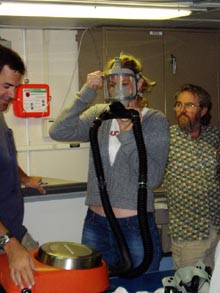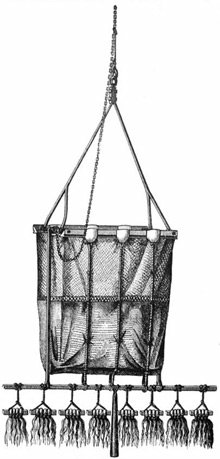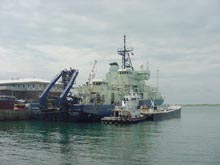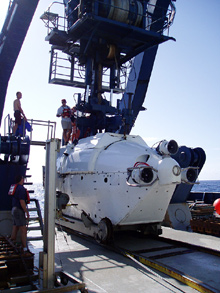Off to Sea!
July 11, 2003
Diana Payne
Connecticut Sea Grant
There is a pleasure in the pathless woods,
There is a rapture on the lonely shore,
There is a society where none intrudes,
By the deep sea, and music in its roar….
-Byron, Childe Harold’s Pilgrimage
The 2003 Mountains in the Sea expedition has departed Woods Hole, Mass., to explore the New England Seamount chain, which extends from Georges Bank off coastal New England to just northeast of Bermuda. The mission plan includes DSV Alvin dives on Manning, Kelvin and Bear Seamounts to survey biodiversity patterns of deep sea corals, fishes and invertebrates. Kelvin Seamount has never before been mapped or explored, so we will make a multibeam map of Kelvin en route to Manning Seamount and use the map to determine where the Alvin will dive later this week.
Prior to departure, the education team conducted two Teacher Professional Development Institutes at Mystic Aquarium and at the Woods Hole Oceanographic Institution Exhibit Center. These sessions introduced educators to mission-specific lessons and activities, and to NOAA’s Office of Ocean Exploration. Science personnel made presentations to explain the goals and objectives of the cruise plan. Additionally, educators were introduced to activities comparing shipboard research and lifestyles aboard the 19th century HMS Challenger and modern research vessels, including the R/V Atlantis.

Graduate student Anne Simpson testing an emergency breathing apparatus for her upcoming Alvin dive. Click image for larger view.
Many of the science and education crew have worked together before on the Deep East 2001 cruise. The team on the first leg of the Deep East expedition had planned to explore Bear and Physalia seamounts, but dives were cancelled due to Hurricane Erin. The science team will return to Bear Seamount on this cruise, as well as several other little known seamounts in the New England chain, to expand on the 2001 work. They will also continue work that was conducted on a recent New England seamount exploration in June 2003. Two members of the Mountains in the Sea shipboard science team participated in the June research cruise. What they learned from that cruise will help us develop and implement our research plan.
While all hands continue to prepare for the mission and adjust to life at sea, former Deep East participants renew bonds with Atlantis crew members who were on board in September 2001. Safety, fire, and abandon ship drills began, and the weather took a turn for the worse as we passed through a cold front. Preparations continue as Alvin and its future occupants prepare for the scheduled dive sequence. All is well, and we are once again off to sea.
Curiosity and Technology in the Deep Sea
July 11, 2003
Maya Crosby, Teacher, Lincoln Academy, Newcastle, Maine
“One dives and returns to the surface inarticulate with amazement…”
-William Beebe, Half Mile Down
Deep sea oceanography seems to be about technology coupled with a fascination with the unknown. The curiosity that caused scientists in London to plan a voyage to the depths of the sea in 1873 still inspires the principal investigators on this cruise. However, it takes a lot of technology to get there. There is so much fancy machinery on this vessel – for the scientific explorations and the comfort of the scientists and crew. It makes me think a lot about the comparison between ocean explorations done in the year 2003 as compared to 1870.

A deep-sea dredge that was used on the HMS Challenger. Image from: Voyage of the HMS Challenger during the years 1873-76: 1885 Narrative of the Cruise. Bossard (2003). Click image for larger view.
I’m sitting here typing on a laptop, having just downloaded some digital images, listening to a CD. The ship has a network, E-mail, and lots of computers. The scientists have brought digital still cameras, digital video cameras and players, microscopes, and a CTD sampling apparatus. The teachers and education crew are able to conduct digital video interviews with the scientists and then upload them to people on shore to be published live on the web. We have just been E-mailing folks back home so that we can set up a live satellite phone conversation with students on shore!
The explorers on the HMS Challenger were so limited in communication that they had to re-use sheets of paper, writing horizontally and then turning the paper and writing across in the other direction.





















